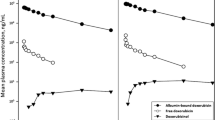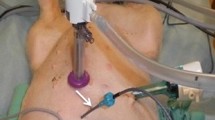Summary
Blood and tissue concentrations of doxorubicin (DOX) were assayed after an intraoperative IV test dose of either free DOX 10 mg or its DNA complex 10 mg to patients with gastrointestinal cancer. After administration of the free drug, blood DOX levels decreased in an at least biphasic way, while DOX-DNA gave higher blood concentrations, which decreased slowly with no clear inflexion point on the concentration-time curve within the first hour. Tissue concentrations of DOX did not differ significantly after the two forms of the drug, liver being the tissue with the highest levels, followed by lymph node metastases, tumor tissue, muscle, and normal intestinal mucosa. If skeletal muscle can be used as a substitute for myocardium, lower cardiotoxicity of DOX-DNA than of DOX is not likely to be due to a difference in tissue uptake and retention between the two forms of DOX.
Similar content being viewed by others
References
Andersson B, Beran M (1980) Leukemic cell versus plasma levels of daunorubicin and daunorubicinol after infusion of daunorubicin as free drug or the DNA complex. Cancer Chemother Pharmacol 4:205
Baurain R, Deprez-De Campeneere D, Zenebergh A, Trouet A (1982) Plasma levels of doxorubicin after IV bolus injection and infusion of the doxorubicin — DNA complex in rabbits and man. Cancer Chemother Pharmacol 9:93
Benjamin RS, Riggs CE, Bachur NR (1977) Plasma pharmacokinetics of adriamycin and its metabolites in humans with normal hepatic and renal function. Cancer Res 37:1416
Benjamin RS, Mason JW, Billingham ME (1978) Cardiac toxicity of adriamycin-DNA complex and rubidazone: Evaluation by electrocardiogram and endomyocardial biopsy. Cancer Treat Rep 62:935
Chan KK, Cohen JL, Gross JF, Himmelstein KJ, Bateman JR, Tsu-Lee Y, Marlis AS (1978) Prediction of adriamycin disposition in cancer patients using a physiologic, pharmacokinetic model. Cancer Treat Rep 62:1161
Ferrant A, Hulhoven R, Bosly A, Cornu G, Michaux JL, Sokal G (1979) Clinical trials with daunorubicin — DNA and adriamycin-DNA in acute lymphoblastic leukemia of childhood, acute nonlymphoblastic leukemia, and bronchogenic carcinoma. Cancer Chemother Pharmacol 2:67
Gil P, Favre R, Durand A, Iliadis A, Cano JP, Carcassonne Y (1983) Time dependency of adriamycin and adriamycinol kinetics. Cancer Chemother Pharmacol 10:120
Hulhoven R, Sokal G, Harvengt C (1979) Human pharmacokinetics of the daunorubicin-DNA complex. Cancer Chemother Pharmacol 3:243
Lee YTN, Chan KK, Harris PA, Cohen JL (1980) Distribution of adriamycin in cancer patients. Tissue uptakes, plasma concentration after IV and hepatic IA administration. Cancer 45:2231
Levi-Schaffer F, Bernstein A, Meshorer A, Arnon R (1982) Reduced toxicity of daunorubicin by conjugation to dextran. Cancer Treat Rep 66:107
Merski J, Daskal Y, Busch H (1978) Comparison of adriamycin-induced nucleolar segregation in skeletal muscle, cardiac muscle, and liver cells. Cancer Treat Rep 62:771
Paul C, Lönnqvist B, Gahrton G, Lockner D, Peterson C (1981) Reducing the cardiotoxicity of anthracyclines by complex-binding to DNA: Report of three cases. Cancer 48:1531
Peters JH, Gordon GR, Kashiwase D, Acton EM (1981) Tissue distribution of doxorubicin and doxorubicinol in rats receiving multiple doses of doxorubicin. Cancer Chemother Pharmacol 7:65
Peterson C, Paul C, Gahrton G (1981) Anthracycline — DNA complexes as slow release preparations in the treatment of acute leukemia. In: Lewis DH (ed) Controlled release of pesticides and pharmaceuticals. Plenum. New York, pp 49–65
Robert J, Hoerni B, Vrignaud P, Lagarde CA (1983) Earlyphase pharmacokinetics of doxorubicin in non-Hodgkin lymphoma patients. Cancer Chemother Pharmacol 10:115
Terasaki T, Iga T, Sugiyama Y, Hanano M (1982) Experimental evidence of characteristic tissue distribution of adriamycin. Tissue DNA concentration as a determinant. J Pharm Pharmacol 34:597
Trouet A, Deprez-De Campeneere D (1979) Daunorubicin-DNA and doxorubicin — DNA. A review of experimental and clinical data. Cancer Chemother Pharmacol 2:77
Trouet A, Deprez-De Campeneere D, De Duve C (1972) Chemotherapy through lysosomes with a DNA — daunorubicin complex. Nature New Biol 239:110
Author information
Authors and Affiliations
Additional information
The work described in this paper was supported by grants from the Swedish Medical Research Council, the Swedish Cancer Society and the Cancer Society in Stockholm
Rights and permissions
About this article
Cite this article
Gunvén, P., Theve, N.O. & Peterson, C. Serum and tissue concentrations of doxorubicin after IV administration of doxorubicin or doxorubicin-DNA complex to patients with gastrointestinal cancer. Cancer Chemother. Pharmacol. 17, 153–156 (1986). https://doi.org/10.1007/BF00306745
Received:
Accepted:
Issue Date:
DOI: https://doi.org/10.1007/BF00306745




